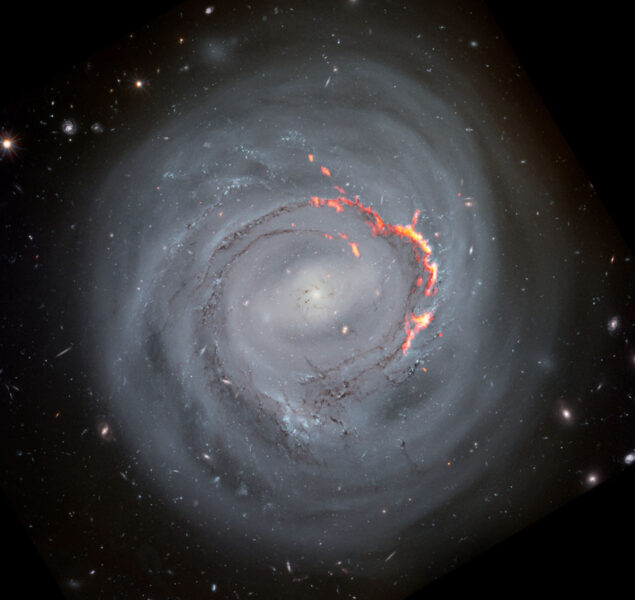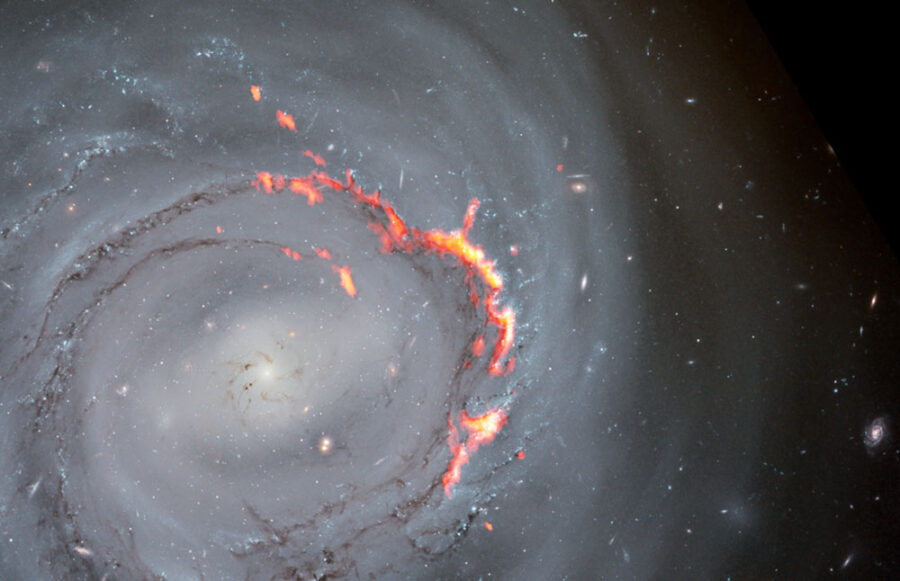Black holes grow and galaxies fall — astro photos and animations to get you through the week.
Falling Galaxy Holds On

ALMA (ESO / NAOJ / NRAO) / S. Dagnello (NRAO), NASA / ESA / Hubble / K. Cook (LLNL), L. Shatz
As the barred spiral galaxy NGC 4921 falls into the Coma Cluster, roughly 320 million light-years away in Coma Berenices, it's losing pieces of itself along the way. But new observations show it's not losing everything.
The space between galaxies in this cluster is filled with tenuous hot gas, and as the galaxy falls into that gas, it feels a wind, just like a biker feels a wind on their face even on a muggy day. This wind, known to astronomers as ram pressure, strips away the galaxy’s gas, removing its star-forming reservoir.
Astronomers have long witnessed the effects of ram pressure in cluster galaxies. But now, using the Atacama Large Millimeter/submillimeter Array (ALMA) in Chile, William Cramer (Arizona State University) and colleagues have captured the first evidence that ram pressure doesn’t always strip everything. Among the gas clouds in NGC 4921, some of them are falling back onto the galaxy. It appears magnetic fields are holding them fast against the wind.

ALMA (ESO / NAOJ / NRAO) / S. Dagnello (NRAO), NASA / ESA / Hubble / K. Cook (LLNL), L. Shatz
The ALMA observations only cover the “leading edge” of NGC 4921 as it falls into the galaxy cluster. There is likely even more gas falling back into other quadrants, Cramer speculates. Additional observations will help quantify just how much gas falls back, prolonging the galaxy’s star-forming life.
Read more in the National Radio Astronomical Observatory's press release and in the study to appear in the Astrophysical Journal (freely available on the arXiv preprint server).
Toward a Full Picture of Black Hole Growth
Angular momentum, or spin, poses a problem for astrophysicists. Nothing is ever at rest: Stars, planets, and galaxies alike are born turning. So how does anything ever fall into the middle: How do stars amass gas, how do planets grow, and how do galaxies feed their central black holes? For anything in this universe to grow or evolve, it first needs to get rid of spin.
A new cosmological simulation shows this process in action for a supermassive black hole at the center of a galaxy, which is itself embedded in a larger halo of hot gas. The simulation shows the flow of gas all the way from the halo, 100,000 light-years out or more, down toward its central supermassive black hole, where streams orbit the behemoth in hundreds of light-days. The sheer range in scale allows this simulation to visualize processes that previous ones couldn't.
“Our simulations show that galaxy structures, such as spiral arms, use gravitational forces to put the brakes on gas that would otherwise orbit galaxy centers forever,” says study lead Claude-André Faucher-Giguère (Northwestern University). “This braking mechanism enables the gas to instead fall into black holes.”
The simulation is realistic enough to show individual supernovae going off in the host galaxy, and stars powering particle winds and intense radiation. However, the simulation does not include any black hole feedback; it provides a picture of how a supermassive black hole would grow in the absence of its own jets or winds, which might carve out a central cavity and slow growth. Incorporating black hole feedback remains a project for the future.
Read more in Northwestern's press release or in the Astrophysical Journal.
 0
0









Comments
You must be logged in to post a comment.